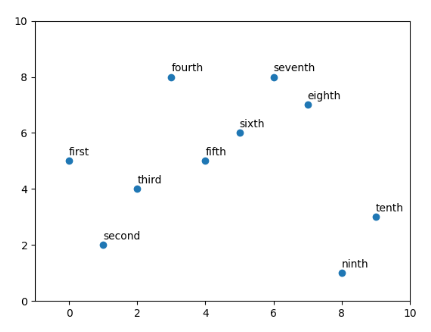

PYQT4 MATPLOTLIB ANNOTATE CODE
Replace deprecated ax.hold(False) with ax.clear()īelow is an adaptation of previous code for using under PyQt5 and Matplotlib 2.0.Directly import Figure instead of pyplot.NavigationToolbar2QTAgg changed with NavigationToolbar2QT.Updated to reflect comments and API changes. # Just some button connected to `plot` methodĭata = Self.toolbar = NavigationToolbar(self.canvas, self) # it takes the Canvas widget and a parent # it takes the `figure` instance as a parameter to _init_ # this is the Canvas Widget that displays the `figure` When embedding Matplotlib in a GUI, you must use the Matplotlib API directly rather than the pylab/pyplot proceedural interface, so take a look at the. Currently matplotlib supports wxpython, pygtk, tkinter and pyqt4/5. import sysįrom _qt4agg import FigureCanvasQTAgg as FigureCanvasįrom _qt4agg import NavigationToolbar2QT as NavigationToolbar You can embed Matplotlib directly into a user interface application by following the embeddinginSOMEGUI.py examples here. Below is a very simple example with a Figure, Navigation and a single button that draws some random data. FigureCanvasQTAgg and NavigationToolbar2QT are usually what you need. _connect("motion_notify_event", self.It is not that complicated actually. _connect("button_release_event", self.on_release) _connect("button_press_event", self.on_press) Vertical_layout = QtWidgets.QVBoxLayout(self)

The frequency of the given cosine signal is 5 Hz. plt.show () In this example, we have our goal is to print the output of a full-wave rectifier for cosine signal. 'axes_leave_event' LocationEvent - mouse leaves an axes plt.xlabel ('Time') plt.ylabel ('output Voltage') tylim (-1, 1) Plot the Annotation in the graph. 'axes_enter_event' LocationEvent - mouse enters a new axes 'figure_leave_event' LocationEvent - mouse leaves a figure 'figure_enter_event' LocationEvent - mouse enters a new figure 'scroll_event' MouseEvent - mouse scroll wheel is rolled 'resize_event' ResizeEvent - figure canvas is resized 'pick_event' PickEvent - an object in the canvas is selected 'motion_notify_event' MouseEvent - mouse motion 'key_release_event' KeyEvent - key is released 'key_press_event' KeyEvent - key is pressed

'draw_event' DrawEvent - canvas draw (but before screen update) 'button_release_event' MouseEvent - mouse button is released Text = "x: ".format(e.x(), e.y())Īs you have noticed the canvas is not handled by Qt but by matplotlib so the solution is to use the events provided by that library, if you review the docs you see that there are the following events:Įvent name Class and description 'button_press_event' MouseEvent - mouse button is pressed My code for this class shown here: from PyQt5.QtWidgets import *įrom _qt5agg import FigureCanvasQTAgg as FigureCanvas When the mouse is over the label (text area), the tracking function seems to be interrupted.
PYQT4 MATPLOTLIB ANNOTATE HOW TO
I found a quite useful link How to return mouse coordinates in realtime?. Since my canvas inherits the matplotlib.figure that is not a QWidget, thus it doesn't have the setMouseTracking() attribute. However, the problem is that I can only track the mouse's position in the padding area except for the canvas area. I want to track the mouse's position over a matplot's canvas in real-time.įor now, I built a MplWidget that inherits the Qwidget (act like a container), then built a canvas over it to show the plot.


 0 kommentar(er)
0 kommentar(er)
